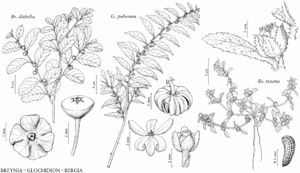Glochidion
Char. Gen. Pl. ed. 2, 113, plate 57. 1776.
| Taxon | Illustrator ⠉ | |
|---|---|---|
 | Glochidion puberum Breynia disticha Bergia texana | Barbara Alongi Barbara Alongi Barbara Alongi |
Shrubs [trees], monoecious [dioecious], hairy [glabrous], hairs simple; branching phyllanthoid. Leaves deciduous [persistent], alternate, simple, scalelike on main-stems, well developed on ultimate branchlets; stipules persistent; blade margins entire. Inflorescences unisexual or bisexual, fascicles [cymules], proximal mostly or entirely staminate, distal mostly or entirely pistillate. Pedicels present [absent]. Staminate flowers: sepals [5–] 6, distinct; petals 0; nectary absent; stamens 3–4 [–8]; filaments and anthers connate; connectives extending beyond anthers as deltoid appendages; pistillode absent. Pistillate flowers: sepals persistent, 6, distinct; petals 0; nectary absent; pistil [3–] 5–10 [–15] -carpellate; styles [3–] 5–10 [–15], connate nearly to apex, unbranched. Fruits capsules. Seeds 2 per locule, rounded-trigonous [ellipsoid]; seed-coat ± fleshy, smooth; caruncle absent. x = 13, 16.
Distribution
Introduced; Alabama, Asia, Pacific Islands, Australia, tropical and subtropical regions
Discussion
Species 200–300 (1 in the flora).
Glochidion exhibits phyllanthoid branching (G. L. Webster 1956–1958), with well-developed leaves and flowers produced only on the deciduous ultimate branchlets and scalelike leaves on all other stems (referred to as main stems in this treatment).
An obligate pollination mutualism similar to the well-known fig-fig wasp and yucca-yucca moth mutualisms has evolved between Breynia, Glochidion, and various Phyllanthus species [particularly subg. Gomphidium (Baillon) G. L. Webster] and the moth genus Epicephala (reviewed in A. Kawakita and M. Kato 2009). Species-specific moths pollinate the flowers nocturnally, with female moths collecting pollen on specialized proboscides and laying their eggs on the pistillate flowers. The developing larvae consume a portion of the seeds, leaving the remainder untouched. Phylogenetic analysis demonstrated that specialized behavior evolved once in Epicephala and that the mutualism has evolved repeatedly within Phyllantheae (Kawakita and Kato).
Selected References
None.
Lower Taxa
"connate" is not a number.